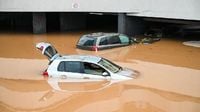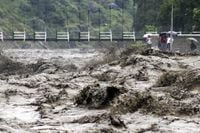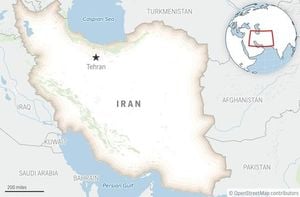On August 26 and 27, 2025, relentless monsoon rains battered northern India and eastern Pakistan, unleashing flash floods and landslides that have left dozens dead, hundreds missing, and over 150,000 people displaced. The worst devastation struck along the revered Hindu pilgrimage route to the Shri Mata Vaishno Devi shrine in Jammu and Kashmir’s Reasi district, where a catastrophic landslide killed at least 34 people and injured around 20 others, according to officials cited by Press Trust of India and ANI.
The tragedy unfolded around 3 p.m. on August 26, as devotees made their way along the winding 12-kilometer trek from Katra to the hilltop shrine. Without warning, the mountainside gave way, sending stones, boulders, and debris crashing down on unsuspecting pilgrims. “The landslides started happening at the Garbh Joon Gufa temple (Ardhkuwari)... The situation was chaotic... People started coming downwards via the Tarakote marg... The ambulances were running to and fro quickly... The yatra has been halted. The returnees are coming down via the Tarakote marg,” recounted Satish Kumar, a devotee from Banaras, to local reporters.
Authorities immediately suspended the pilgrimage and launched a large-scale rescue operation. The National Disaster Response Force (NDRF), Central Reserve Police Force (CRPF), Border Security Force (BSF), and other central agencies were mobilized, with 17 NDRF teams and 32 special boats airlifted to the disaster zone. The Indian Air Force also deployed 124 NDRF personnel and a fleet of aircraft for flood relief in Jammu, as reported by PTI and ANI.
Jammu and Kashmir Lieutenant Governor Manoj Sinha visited hospitalized victims at SMVD Narayana Superspeciality Hospital, urging doctors to ensure the best possible care. “My gratitude to emergency responders, SMVDSB employees & citizens whose exemplary interventions saved many lives,” Sinha said, according to his office.
Prime Minister Narendra Modi took to social media to express his condolences: “The loss of lives due to a landslide on the route to the Shri Mata Vaishno Devi Temple is saddening. My thoughts are with the bereaved families. May the injured recover at the earliest. The administration is assisting all those affected. My prayers for everyone's safety and well-being.” Jammu and Kashmir Chief Minister Omar Abdullah also spoke with Modi, who assured that the central government would provide all necessary assistance. “There is some relief today as the rain has almost stopped. Water has started receding from the low-lying areas. The loss due to the disaster is before you... Relief and rescue work has started,” Abdullah told reporters.
The devastation was not limited to the pilgrimage route. Heavy rainfall since August 25 caused widespread flooding across the Jammu region, as well as parts of Himachal Pradesh and Punjab. Jammu recorded its highest 24-hour rainfall at 296.0 mm, with the India Meteorological Department reporting an even higher 368 mm near Jammu on August 26. As a result, all government and private schools across Jammu division were ordered shut, and Class 10 and 11 board exams postponed. Colleges and universities also closed as a precaution, and train services to and from Katra, Udhampur, and Jammu were canceled, leaving thousands of passengers stranded.
Floodwaters surged through low-lying areas and villages in districts like Samba, Kathua, Udhampur, and Doda, where four additional deaths were reported due to rain-related incidents. Major rivers—including the Chenab, Tawi, Ravi, Ujh, Basantar, and Sahar Khad—rose above or near danger levels, inundating communities and forcing widespread evacuations. Police and local authorities urged residents to avoid traveling on highways and to stay clear of rivers and water bodies, as landslides and road blockages persisted.
Communication networks collapsed in many areas after optical fiber cables were severed by flooding and landslides. “Adverse weather conditions are prevailing... The situation is being closely monitored. Irrigation and flood control teams are continuously monitoring from South Kashmir to North Kashmir. Our water gauge levels are being monitored closely at Sangam, Anantnag, and Ram Munshi Bagh. All our DCs of South Kashmir and Central Kashmir are on spot... We had closed schools, colleges and universities last night as a precautionary measure,” said Srinagar official Anshul Garg.
In neighboring Pakistan, the situation was equally dire. Torrential rains caused major rivers in Punjab province to swell, inundating villages and displacing more than 150,000 people. Over 20,000 residents were evacuated overnight from the outskirts of Lahore, Pakistan’s second-largest city, which faces the risk of flooding from the swollen Ravi River. “Those evacuated from areas near Lahore are living along the banks of the Ravi River,” said Irfan Ali Kathia, director general of the Punjab Disaster Management Authority, as reported by Arab News and Tempo.
Mass evacuations had begun earlier in the week across six districts of Punjab after heavier-than-usual monsoon rains and overflow from Indian dams triggered flash floods in the low-lying border areas. Rescue teams, often using boats, worked around the clock to move people to safer ground. Floodwaters in the Ravi, Chenab, and Sutlej rivers continued to rise dangerously in districts such as Kasur, Okara, Bahawalnagar, Bahawalpur, Vehari, and Sialkot. Prime Minister Shehbaz Sharif praised the authorities for timely evacuations and confirmed that relief supplies and tents were being provided to those affected.
India issued fresh flood risk alerts to Pakistan on August 25-27, warning of a "high probability" of flooding in the Tawi river due to heavy rainfall and dam water releases. The alerts were sent on humanitarian grounds through the Ministry of External Affairs, even as diplomatic relations remained tense following a terror attack in Pahalgam four months earlier. Notably, these warnings were not transmitted through the Indus Water Commission, the permanent mechanism established by the World Bank-mediated Indus Water Treaty in 1960, as New Delhi suspended the commission’s work after the deaths of 26 tourists in April.
Since late June, floods have killed more than 800 people in Pakistan, with nearly 100 deaths in the Himalayan region during August alone. Scientists, cited by Tempo, warn that climate change is intensifying monsoon rains across South Asia, raising fears of disasters on the scale of the 2022 floods that submerged a third of Pakistan and claimed 1,739 lives.
Back in India, the response to the crisis has seen both compassion and calls for accountability. Uttar Pradesh Chief Minister Yogi Adityanath announced financial assistance of Rs 4 lakhs for the families of the deceased from his state, and directed officials to ensure the bodies were returned home. Yet, there were also pointed questions about preparedness. “If we already knew about the weather, couldn't we do something to ensure that those innocent lives were saved? Why were they on the track? Why weren't they taken to a safe place?” asked Chief Minister Omar Abdullah, reflecting on the many lives lost along the pilgrimage route.
As skies begin to clear and water levels slowly recede, the full scale of the disaster is coming into focus. Relief and rescue operations continue in earnest, but the scars left by these floods—on families, communities, and the region’s fragile infrastructure—will not soon be forgotten.






